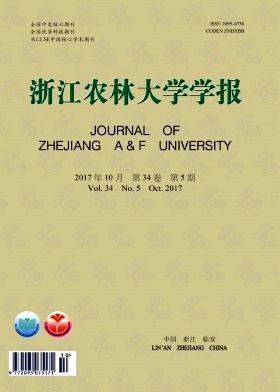-
竹材具有与木材相似的质感,且具有比木材生长快、韧性好等优点。近年来竹材在传统木材应用领域内被广泛利用[1]。作为一种天然生物材料,其自身的结构决定了竹材具有较强的湿胀干缩性,这影响了竹材的尺寸稳定性,也使得竹材制品在使用时易产生开裂、变形等缺陷[2]。浸润性与材料的疏水性有关,是固体表面一个重要的特征。影响材料表面浸润性的因素既有内在的如其微观结构、化学组成[3-8],又有外在的因素如光、电、热以及溶剂等[9-19]。自然界经过数十亿年的长期进化,生物表面的微纳米多尺度结构可赋予材料表面特殊的浸润性能,如超疏水、自清洁、超亲水、高黏附力和光反射等[20-21]。荷Nelumbo nucifera叶表面的纳米乳凸结构使其具有超疏水、自清洁特性,水滴在其表面有较大的接触角和极小的滚动角,微小的倾角即可使水珠滚动离开荷叶表面,生物体表面具有此类特征的现象被称为“荷叶效应”[22-24];此外,一些生物体表面具有与荷叶自清洁相反的特性,如月季Rosa chinensis花瓣表面不仅具有较大的接触角,而且还有较大的接触角滞后,与水有很强的黏附力,即使将月季花瓣旋转90.0°甚至180.0°,水珠仍可稳固地钉驻在花瓣表面,展现出超疏水及高黏附特性。这是因为月季花瓣的乳突阵列状微米结构和乳突顶部凹槽状纳米褶皱结构而产生的具有层次的微纳结构粗糙表面,通常将表面具有此类现象定义为“花瓣效应”[25-26]。由于多数生物结构非常精细复杂,因此,直接采用传统的人工方法很难制备出类似的结构。软印刷技术[27]是一种仿生领域广泛应用的方法,是以弹性体模具为核心,用模具转移图形结构至特定基片的表面。受生物启发,本研究利用软印刷技术[28]以新鲜月季花瓣为模板,聚二甲基硅氧烷(PDMS)为印章,经2次复形将月季花瓣表面的微观形貌转印在竹材表面,从而使竹材具有类月季花瓣的超疏水高黏附特性,可解决竹材在加工或使用时因吸水性而产生开裂、变形等缺陷可大大延长竹材的使用寿命和增加其附加值。
HTML
-
3年生的毛竹Phyllostachys edulis购自浙江省临安市,将足够长的试样去除竹青、竹黄,刨成所需宽厚后再截断成尺寸规格(长×宽×高)为10 mm × 10 mm × 5 mm的竹材试件。
将竹材试件在去离子水中超声清洗60 min后放置60 ℃的恒温恒湿箱中6.0 h。弹性印章聚二甲基硅氧烷(PDMS)及固化剂(184 SEB,silicone elastomer base)按比例15:1配置,购自美国Dow Corning公司。无水乙醇、聚乙烯醇(PVA)均为分析纯试剂,购自中国上海博伊尔化工有限公司,可直接使用。实验用水均为去离子水。月季花瓣,摘自浙江农林大学图书馆旁。
-
具体实验操作流程如图 1所示:① 把PDMS与固化剂按15:1混合,经充分搅拌后静置,直至气泡完全消失。然后把2片月季花瓣修剪成合适大小后,分别平铺在2个培养皿中,倒入先前配好的PDMS与固化剂的混合溶液,放置真空容器中除去气泡,随后放入烘箱中,60 ℃烘干至其完全固化,最后将PDMS膜与花瓣分离,所得的PDMS膜就是具有月季花瓣表面结构的母版。② 配制100.0 g·kg-1的聚乙烯醇(PVA)溶液,称取6.0 g的PVA于烧杯中,加入54.0 g的蒸馏水,静置0.5 h溶胀,然后放入油浴锅中,80 ℃磁力搅拌至溶液澄清。用玻璃棒将PVA溶液均匀涂抹在竹材试样上,然后把它压紧在PDMS印章上,常温下放置12.0 h后,把竹材试样与PDMS薄膜分离就得到了具有月季花瓣正面结构的竹材试样。
-
样品表面的形貌通过扫描电子显微镜(SEM,FEI,Quanta 200)进行了观测。试样的润湿性采用OCA40接触角仪(德国Dataphysics),在室温下对样品的一个表面取5个不同部位进行接触角的测定,取其结果的平均值为所得接触角。
1.1. 材料
1.2. 仿类月季花竹材样品的制备
1.3. 表征
-
图 2A与图 2B为水滴在新鲜月季花瓣的照片,水滴在其表面呈球形水珠,说明月季花表面具有疏水性能;同时,可以观察到无论月季花瓣倾斜或反转180.0°,水滴依然牢牢吸附在各自表面上,这是具有高黏附性的表现。竹材制品在实际使用中,不仅有一定的防水性,还需要一定的耐酸耐碱性。图 2C~2E为表面仿生后的竹材。图 2C中从左到右的小液滴分别是10.0 g·kg-1的氯化氢溶液、蒸馏水、10.0 g·kg-1的氢氧化钠溶液,观察发现竹材试样的酸碱小液滴都与水滴表现出相似的疏水性,而且竹材表面没有被腐蚀,经接触角测定,表面滴有稀盐酸和氢氧化钠溶液的竹材,其接触角分别为151.5°和151.0°,接近水滴在其表面的接触角。因此,可知仿生后的竹材试样在具有一定的酸碱环境下仍具有良好的疏水特性。在图 2D中将有水滴的竹块竖直放置后,小水滴牢牢吸附在其表面上,表明复型的竹材已经具有了类似于新鲜月季花瓣的疏水性与高黏附性。EVA乳液(乙烯-醋酸乙烯共聚物)主要用作黏合剂及涂层。图 2E中,将EVA乳液滴在竹材表面,然后把竹材试样翻转180.0°,EVA也没有掉落,说明复型后的竹材对涂料也有较强的附着力。
接触角来表征材料的浸润性,一般把接触角小于90.0°的称为亲水材料,大于90.0°的称为疏水材料,而接触角大于150.0°的则称为超疏水材料。对试样表面不同位置测量5次后取其平均值,普通竹材接触角大约为16.5°±2.0°(图 3A),证明竹材是亲水材料。月季花瓣表面的接触角为157.5°±2.0°(图 3B),因而它表现出了良好的超疏水性。而仿生复型得到的竹材的接触角为153.5°±2.0°(图 3C),其疏水效果接近月季花瓣的性能。发现经仿生复型后,竹材的疏水性有了明显提高,由亲水材料转化为超疏水材料,同时竹材试件也表现出了与月季花瓣类似的高黏附性,水珠可以稳定地停留在试件表面(图 3D和图 3E)。图 3F是水滴在竹材/PVA表面的接触角为39.5°±2.0°,由于PVA含有—OH(羟基),属于亲水性高分子聚合物;与经月季花瓣仿生复型的竹材表面相比,PVA表现为亲水性,因此,证明试件的疏水特性是由于月季花瓣表面结构所引起的。

Figure 3. Contact angle of droplets on (A) bamboo, (B) Chinese rose (C, D, E) and bamboo specime surface (F)/PVA
扫描电镜下观测到竹材,月季花及仿生月季花竹材样品的表面结构如图 4所示。图 4A为原始竹材试件表面,可看出竹材具有较为光滑的表面微观结构,纤维纹理清晰可见。图 4B是月季花瓣在SEM 50 μm下的微观结构,可以看到月季花花瓣上表面的细胞向外突起呈半球状, 排列紧密大小不一的乳突。其表面直径约30 μm,高度约10 μm,乳突表面由条纹状纳米级的皱褶构成,这样的结构使得水滴能进入乳突间的沟槽,而更加微小的褶皱则不容易进去,在宏观上就表现出超疏水与高黏附的特性。图 4C是复型后竹材的微观结构,其表面具有了与月季花瓣表面类似的微纳乳突结构,且表面较图 4A更为粗糙,证明PDMS成功地将月季花表面微结构转印在竹材上,得到表面具有类月季花微纳结构的竹材样品。这与图 2和图 3的结果一致。
-
本研究通过软印刷技术将月季花表面多层微纳结构成功地复制在竹材表面,使竹材表面的接触角达到150.0 °以上,获得与月季花类似的超疏水高黏附性能,可以有效阻止水分的侵害;同时,良好的黏附力还可增强竹材对涂料的附着力。本研究不仅加深了对自然界中遗态材料表面超疏水机制的认识,也为竹材表面防水研究提供了新的方向,仿生超疏水高黏附特性竹材的成功制备可延长竹材的使用期限,拓宽竹材行业的发展领域。













 DownLoad:
DownLoad:


